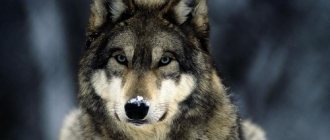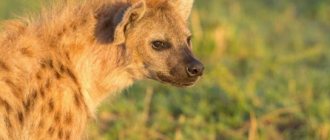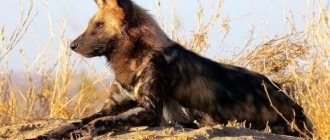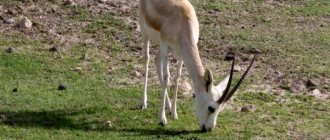- Wild animals
- >>
- Mammals
The maned wolf is a predatory animal from the canid family. It is now believed that such a wolf is a unique representative of its kind and very interesting because of its unusual appearance. The maned wolf is very similar to the red fox with slender and very long legs. Also known as guara, maned wolf, aguarachai, which translated from Greek into Russian means “a dog with a short golden tail.”
Origin of the species and description
Apart from the fact that there are significant similarities in appearance between the fox and the maned wolf, there are no other similarities noted between them. They are not blood relatives. Scientists noted that most likely its roots originate from ancient South American canids that lived during the Pleistocene period (ended 11.8 thousand years ago BC).
Video: Maned wolf
As already noted, aguarachai comes from the canine family, which unites fairly large or medium-sized predators. Basically, the body length of representatives of this genus reaches 170 centimeters. Thick fur, long tail, non-sharp claws, erect ears, long head are the main characteristics of their genus. Also, they have 5 toes on the front paws, but only 4 on the hind paws. The color of the coat can be of various shades: red, spotted, dark, black, gray, light, and so on. They have a well-developed sense of smell, hearing, and vision. Can run at a speed of 60 - 70 km/h.
Appearance and features
Photo: Maned wolf
It differs from its relatives in that it is more similar to a fox. He has long and very slender legs. The body length is relatively small (about 140 cm), weight is approximately 25 kg. He has 42 teeth, like all wolves. General coat color: red, red-yellow. There is long hair in the middle of the back and near the back of the neck. Their color can be either dark or black. The lower parts of the legs are black. The muzzle is long and dark in color.
The fluffy long tail is most often light yellow in color. The coat is quite softer than that of ordinary dogs. The ears are straight and quite large, and the eyes are small with round pupils. The figure of this wolf is very disproportionate. The perception of various smells and hearing in the guara are very well developed, but their vision is slightly worse.
His feature is long and slender legs. They help to walk in places where there is very tall grass. According to scientists, the legs became longer during the process of evolution when animals adapted to their new habitat.
But the guar cannot boast of running speed. You may ask why, because she has such long legs? The reason is that the lung capacity is very small, which prevents the animal from running very fast. The lifespan of a guara is about 17 years, but in captivity the animal can die even at the age of 12 years. However, there are cases that can live up to 15 years.
Where does the maned wolf live?
Photo: Animal maned wolf
The maned wolf can be found in the countries of South America, in the state of Mato Gosu, Northern Paraguay, in the central and northeastern parts of Brazil, and eastern Bolivia. It was once common in Argentina. The maned wolf is more adapted to temperate climates. Wolves of this species do not live in the mountains.
The main places where the beast lives or can be found:
- Forest edges;
- Places with tall grass or bushes;
- Pampas;
- Lowland areas;
- The edges of swamps that are overgrown with vegetation.
Melville Island wolf
Author: Quartl/commons.wikimedia.org
This subspecies of a beautiful and graceful wolf is found on the Arctic islands of North America. It was from one of the islands where it lived that it got its beautiful and unusual name - Melville.
It stands out among its relatives with its beautiful white or grayish-white coat color.
The Melville wolf hunts in packs, driving musk oxen and large reindeer. In search of food, reindeer travel vast distances of thousands of kilometers. Wolves are forced to follow the herds of deer.
Like the Arctic wolf, it initially lives in the natural territories of its habitat, since there is no competition with humans there.
6
What does the maned wolf eat?
Photo: What a maned wolf looks like
In terms of the way it eats, the maned wolf is an omnivore. The term “omnivore” means “to eat a variety of foods.” From this we can conclude that animals with this type of diet can eat food not only of plant, but also of animal origin, and even carrion (dead remains of animals or plants). This also has its advantages, because such animals are unlikely to die of hunger, because they can find food in any place.
The basis of this wolf’s diet is food of both animal and plant origin. In frequent cases, these are small animals, such as spiders, snails, various insects, hares, rodents, birds and their eggs, armadillos, and rats. Sometimes it can attack domestic animals (lamb, chicken, pig). There have never been any cases of attacks on people. Also, he loves to eat various delicious fruits, bananas, roots or tubers of plants, guava, plant food, leaves. Bananas are their favorite fruit. They can eat more than 1.5 kilograms of bananas in one day!
If there is a river nearby, the wolf can catch various fish and reptiles. Doesn't like to share food. Unlike other omnivores, the maned wolf does not feed on carrion. An important component of the maned wolf's food is a plant from the genus Nightshade, which helps destroy the giant parasitic worm in the animal's intestines, known as pileworm. It is known that such adult worms can reach 2 meters in length. They are dangerous to the lives of animals.
Before catching prey, the wolf either drives it into a corner, or taps its paws and then suddenly attacks it. In frequent cases, if he lives near farms, he steals food. It is worth noting that its mouth muscles are not sufficiently developed, so most often it swallows prey whole. From this we can conclude why the maned wolf does not hunt large prey.
Nutrition
Predators feed mainly on small animals (birds, snails, insects, eggs), swallowing food and not chewing at all, since they have rather weak jaws to feed on large animals.
The jaws are not so developed as to break and crush hard, huge bone. Also, they are not averse to eating poultry, thereby turning people against themselves.
Of course, such cases happen rarely, but they do happen. Fortunately, they do not attack people; not a single case of attack has been recorded yet.
The wolf is also good-natured towards humans. In addition to meat, these animals also eat plant foods, preferring bananas. Wolves also love to eat fruit such as wolfberry.
Wolfberry is considered very poisonous, but it helps the predator get rid of many parasites that live in its body. But, a very interesting fact is that during the ripening period of berries, such as strawberries, strawberries and others, a predator may well include them in its diet.
Features of character and lifestyle
Photo: Aguarachay
The character and lifestyle of the maned wolf have not been sufficiently studied by scientists. But some of them are facts that are quite accurate. In the minds of many people, the wolf is a very angry animal. But in reality this is not always true. The character of the maned wolf is calm, balanced, and cautious. He does not attack people, but on the contrary tries in every possible way to avoid being seen by them. The character of a wolf can be traced to the character traits of a fox - cunning, deceit. This trait is especially evident when the wolf steals from farmers their farm.
And another very important trait is loyalty. A wolf lives with only one female throughout its life. Also, they love to be independent. This confirms the fact that they are not in packs, because will comes first for them. When an animal is angry or aggressive, the mane near its neck stands on end. It gives the animal a more terrifying expression.
The lifestyle of maned wolves is quite interesting - during the day they sleep, rest, bask in the sun, play, and in the evening or night they go hunting. They live alone and are not in packs. The activity of males is much higher than that of females.
Females and males hunt or rest separately from each other. Only during the mating season do they spend a lot of time together. Maned wolves often communicate using certain sounds.
Here are a few of them:
- Loud throat bark - indicates sunset;
- A loud, long howl – communicating with each other over long distances;
- Dull grunt - scaring away enemies;
- Snorting is a warning of danger;
- Single howl – maintain communication over short distances.
Social structure and reproduction
Photo: Maned wolves
As noted above, maned wolves live with only one female throughout their entire lives, unlike other animals. The couple occupies an area of approximately 30 square meters for themselves, which is not allowed for others to approach. To mark their territory, they mark it with their urine or small pieces of feces in certain areas. And at the same time, only wolves understand such a smell. A person will never be able to understand this in his life.
At one year, maned wolves fully reach sexual maturity, but at two or three years they are considered fully ready to create their own family. The mating season, breeding occurs in mid-autumn and early winter. Estrus in females lasts from April to early June, and pregnancy lasts 2 months (63 days). In most cases, from two to six puppies are born (as newborn wolves are called).
Newborn wolf cubs are born very tiny, with an approximate weight of 200 - 400 grams. Their body is dark black or gray and has a small light tail. For the first nine days they cannot see anything. After a month, their ears are almost completely formed, a characteristic brown body color appears along with a loose fur coat, and teeth are erupting. Until the age of three, the mother feeds her children with milk and soft food, which she first chews and then spits out.
Both the wolf and the she-wolf are involved in raising their children. The male actively helps the mother in raising and maintaining the family. He gets food, scares enemies away from the kids, teaches them the laws of nature and plays various games with them.
Habitats
Unfortunately, in our time, the wolf's habitat has noticeably decreased; in past times, wolves lived throughout the territory of Eurasia and North America, where humans lived. For example, historical chronicles indicate that during the Hundred Years' War between England and France there was such great devastation and desolation that wolves even appeared on the streets of Paris. Now, of course, you are unlikely to meet a wolf not only in the vicinity of Paris but also in other cities; they remain, and even then in small numbers, in wild places, including in our Carpathians, in the Siberian taiga.
Wolves are social animals that live in packs, which always have a pair of leaders: a male and a female. The remaining members of the pack: the offspring of the leaders, their relatives or lone wolves who have joined are subject to a strict hierarchy. A pack of wolves has its own area of territory, up to 300 square kilometers, which they mark with special odorous marks that serve as a warning to intruder wolves.
Natural enemies of the maned wolf
Photo: Guara
Scientists have not been able to identify the real enemies of the maned wolf in real nature. Most likely they are not there because they are friendly and try to avoid the eyes of large predators. But we are definitely sure that his main enemy is man and his negative activities. At the same time, people do not need the wool or meat of this animal; the reasons are deeper. Here are some of them:
- Farmers kill the wolf just because it steals their pets;
- Some African peoples use its skin and eyes as a talisman for medicinal remedies;
- Poaching;
- Lack of food, exhaustion, disease;
- People cut down trees, pollute water and air, and take away their territories.
Security
Although these days the maned wolf is less and less hunted for fun or a beautiful pelt, humans remain its enemy for many other reasons. One of them is dubious accusations of theft of chickens and other livestock; the other is capture for sale to zoos. The most serious threat to this species is the destruction of its habitat - the expansion of cultivated areas and the annual burning of grass cover in the pampa. Maned wolves are susceptible to many parasitic infestations and infections.
In Uruguay, the maned wolf disappeared in the 19th century, but its range expanded westward into the deforested zone of central Brazil. It is protected by law in Argentina and Brazil, but its survival remains highly problematic. Since 1978, the World Wildlife Fund has been studying the maned wolf in an effort to prevent its extinction.
Many superstitions surround the maned wolf. His nightly cries are considered a sure sign of changing weather. In Brazil, there is a cruel belief that an eye torn out from a living wolf brings happiness, and a decoction from the shavings of its bones supposedly facilitates childbirth.
Population and species status
Photo: Maned wolf from the Red Book
The maned wolf population has hit record lows in recent years. Experts estimate that there are no more than ten thousand adult individuals left worldwide. And in Brazil there are only about 2000 of them. The status of the maned wolf is listed in the International Red List as a “endangered species.” Even 2 centuries ago, it was a popular species of wolf in the territories of Uruguay.
It is worth noting that maned wolves are susceptible to diseases such as plague and other equally serious ones. It is they who pose a threat to the lives of these animals to the same extent.
Interesting Facts
mushrooms,” but they also drank wolf blood and wore the skins of these animals.











